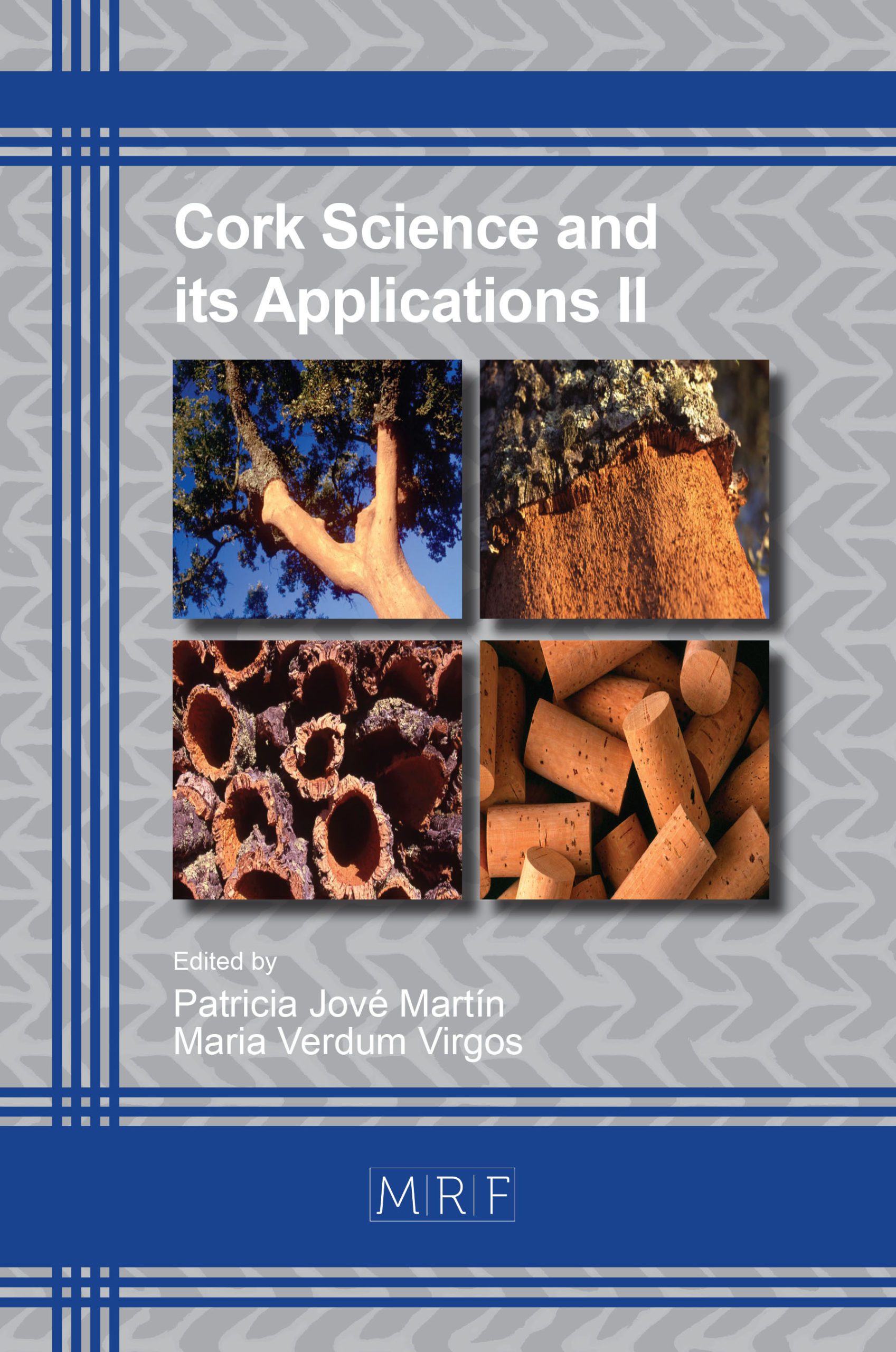A New 3D Print Technology Filament 100% Based in Natural Biological Sources and Cork Waste
Flávia A. VIEIRA, Sara P. M DA SILVA, José M. DE OLIVEIRA
Abstract. Lately, there is an increasing demand for natural and sustainable materials, which contributes to the natural appealing of cork uses. Cork industry produces around 30 % wt of residues in powder form. The main goal of this work is to use cork as reinforcing phase in a maize starch thermoplastic (TPS) matrix producing a cork-polymer composite (CPC) from 100 % natural sources. The starch thermoplastic matrices were produced using three different weight proportions of starch. Cork powders with granulometries ranging from 63µm-80µm were considered. The moisture absorption was evaluated during 16 weeks in a shelf-life storage experiment. The morphological characteristics were performed by SEM images and chemical profile by spectrometric and thermal analysis. Both TPS and CPC formulations were characterized in terms of moisture absorption. All infrared spectra were pre-treated and analyzed under multivariate statistics. The samples with lower moisture absorption and best group of results for chemical and morphological characterization were selected for further mechanical tests and 3D filaments production.
Keywords
Biobased and Biodegradable Cork-Composite, Cork Powder, Thermoplastic Starch Blends
Published online 9/20/2019, 6 pages
Copyright © 2019 by the author(s)
Published under license by Materials Research Forum LLC., Millersville PA, USA
Citation: Flávia A. VIEIRA, Sara P. M DA SILVA, José M. DE OLIVEIRA, A New 3D Print Technology Filament 100% Based in Natural Biological Sources and Cork Waste, Materials Research Proceedings, Vol. 14, pp 35-40, 2019
DOI: http://dx.doi.org/10.21741/9781644900413-6
The article was published as article 6 of the book Cork Science and its Applications II
References
[1] Zia-ud-Din, H. Xiong, and P. Fei, Physical and chemical modification of starches: A review, Crit. Rev. Food Sci. Nutr., 57, 12, (2017), 2691–2705. https://doi.org/10.1080/10408398.2015.1087379
[2] J. Waterschoot, S. V. Gomand, E. Fierens, and J. A. Delcour, Starch blends and their physicochemical properties, Starch – Stärke, 67, 1–2, (2015), 1–13. https://doi.org/10.1002/star.201300214
[3] T. Mekonnen, P. Mussone, H. Khalil, and D. Bressler, Progress in bio-based plastics and plasticizing modifications, J. Mater. Chem. A, 1, (2013), 13379. https://doi.org/10.1039/c3ta12555f
[4] A. A. Aydın and V. Ilberg, Effect of different polyol-based plasticizers on thermal properties of polyvinyl alcohol:starch blends, Carbohydr. Polym., 136, (2016), 441–448. https://doi.org/10.1016/j.carbpol.2015.08.093
[5] M. G. A. Vieira, M. A. da Silva, L. O. dos Santos, and M. M. Beppu, Natural-based plasticizers and biopolymer films: A review, Eur. Polym. J., 47, 3, (2011), 254–263. https://doi.org/10.1016/j.eurpolymj.2010.12.011
[6] M. R. Area et al., Corn starch plasticized with isosorbide and filled with microcrystalline cellulose: Processing and characterization, Carbohydr. Polym., 206, (2019), 726–733. https://doi.org/10.1016/j.carbpol.2018.11.055
[7] R. F. Tester, J. Karkalas, and X. Qi, Starch—composition, fine structure and architecture, J. Cereal Sci., 39, 2, (2004), 151–165. https://doi.org/10.1016/j.jcs.2003.12.001
[8] Y. Zhang, C. Rempel, and Q. Liu, Thermoplastic Starch Processing and Characteristics—A Review, Crit. Rev. Food Sci. Nutr., 54, 10, (2014), 1353–1370. https://doi.org/10.1080/10408398.2011.636156
[9] K. M. Dang and R. Yoksan, Development of thermoplastic starch blown film by incorporating plasticized chitosan, Carbohydr. Polym., 115, (2015)575–581. https://doi.org/10.1016/j.carbpol.2014.09.005
[10] L. Tan, Q. Su, S. Zhang, and H. Huang, Preparing thermoplastic polyurethane/thermoplastic starch with high mechanical and biodegradable properties, RSC Adv., 5, 98, (2015), 80884–80892. https://doi.org/10.1039/C5RA09713D
[11] J. F. Mendes et al., Biodegradable polymer blends based on corn starch and thermoplastic chitosan processed by extrusion, Carbohydr. Polym., 137, (2016), 452–458. https://doi.org/10.1016/j.carbpol.2015.10.093
[12] S. P. Silva, M. A. Sabino, E. M. Fernandes, V. M. Correlo, L. F. Boesel, and R. L. Reis, Cork: properties, capabilities and applications, 2005. https://doi.org/10.1179/174328005X41168
[13] I. M. Aroso, A. R. Araújo, R. A. Pires, and R. L. Reis, Cork: Current Technological Developments and Future Perspectives for this Natural, Renewable, and Sustainable Material, ACS Sustain. Chem. Eng., 5,. 12, (2017), 11130–11146. https://doi.org/10.1021/acssuschemeng.7b00751
[14] S. P. Magalhães da Silva, P. S. Lima, and J. M. Oliveira, Rheological behaviour of cork-polymer composites for injection moulding, Compos. Part B Eng., 90, (2016) 172–178. https://doi.org/10.1016/j.compositesb.2015.12.015
[15] J. Čopíková et al., Influence of hydration of food additive polysaccharides on FT-IR spectra distinction, Carbohydr. Polym., 63, 3, (2006), 355–359. https://doi.org/10.1016/j.carbpol.2005.08.049
[16] Y. Zhong and Y. Li, Effects of glycerol and storage relative humidity on the properties of kudzu starch-based edible films, Starch – Stärke, 66, 5–6, (2014), 524–532. https://doi.org/10.1002/star.201300202
[17] H.-Y. Wang and M.-F. Huang, Preparation, characterization and performances of biodegradable thermoplastic starch, Polym. Adv. Technol., 18, 11, (2007). https://doi.org/10.1002/pat.930
[18] H. A. Pushpadass, D. B. Marx, and M. A. Hanna, Effects of Extrusion Temperature and Plasticizers on the Physical and Functional Properties of Starch Films, Starch – Stärke, 60, 10, (2008), 527–538. https://doi.org/10.1002/star.200800713
[19] R. Shi et al., Ageing of soft thermoplastic starch with high glycerol content,J. Appl. Polym. Sci., 103, 1, (2007) 574–586. https://doi.org/10.1002/app.25193































